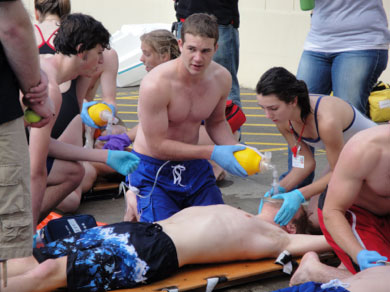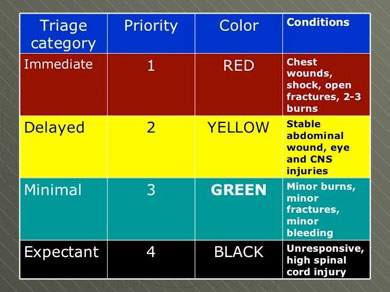
REACTION vs RESPONSE
Which Are You Doing?
What Is The Difference?
As a teenager growing up near lakes, rivers and an abundance of pools, like many in my neighborhood I spent weekends in April in lifeguard training. It was my initiation to the world of first responders. A world where the instructors where both teachers and coaches. After instruction we practiced. If the straps were too loose or the compressions too fast we started from the beginning. It was the perfect place to introduce the different between Reaction and Response.

It wasn’t until later in life that the differences would be made crystal clear. During a Wilderness First Responder class a student simply asked how decide between treating a neck injury and a bad laceration.
Her response – “Your job is to React slowly and Respond quickly. . . someone in a lot of pain can live for a long time, someone who has lost a lot of blood can not.”
She wanted us to know that reacting slowing meant leaving time to assess the whole situation. Responding meant taking action with focus and purpose after assessment. One of the most important components of a well thought out response is the identification of all the possible victims.

1 – Triage Matrix
Often in incident response, those making the most noise are not the ones with the greatest need.
A REAL LIFE SCENARIO: While coaching my crew team from a motor launch I received a call that there had been a cliff jumping accident. Being closest, I was asked to respond. My assistant coach and I approached the 60ft cliff where there was a young girl in hysterics. Screaming and sobbing she sat on an outcropping just to the side of the cliff holding her wrist. My assistant believed she must have injured herself climbing up or down the ledge and wanted to go help her.
The Typical Initial Reaction – Address the person clambering for the most attention while repressing any visceral reactions to the gruesomeness of the scene.

As I idled the boat closer. It was obvious my assistant coach was growing impatient with my lack of haste. Her cries for help could be heard across the lake. Just as my assistant was about to say something I handed her my phone, began loosening the backboard carrier and asked her to radio for help. We would be needing a water rescue. At the bottom of the cliff about 100 ft away was young man. His arm and a head barely above water were grasping to some tree roots.
The Response Plan – Identify those with the greatest need or risk to life and address their most critical ailments.
He was breathing but unconscious. As we pulled him out on the backboard we could see both his tibias. They had compound fractured through his shins from hitting the base of the cliff. While applying pressure the bleeding slowed. The young man slowly regained consciousness. One of the first things he said before I transferred him to EMS “Don’t tell my mom I was here. I told her I had an SAT study group”

2 Things I’ll never forget
- How easy it would have been to overlook the young man in the water (another few minutes without action and he may not have made it).
- Even in the face of a life changing injury he cared more about his mom finding out than if he would ever walk again.
There are 5 steps I take in any emergency situation to help slow my reaction down. Most apply directly to today’s business environment
- I’m #1– If you / your company are not healthy and functional you can’t help customers or business partners – take care of your needs first
- What happened to you?– Identify the mechanisms causing harm – being specific will be important for understanding business needs and your ability to help
- Not on me!– Personal Protective measures are import for first responders and right now the population as a whole.
- Are there any more?– Identify the health of 3rd and 4th party companies who’s health matters to the network overall.
- Are they still alive?– Identify those who you CAN help – resources are limited and should not be wasted
The whole planet now finds itself dealing with a global pandemic. As a species we are being thrust into action. There is no more poignant a time to determine whether we’re reacting or responding. Maybe a full medical style triage matrix is the tool most needed. For many, simply identifying Urgent – Non-important tasks using an Eisenhower – Matrix will pay dividends.

“Your job is to React slowly and Respond quickly . . . someone in a lot of pain can live for a long time, someone who has lost a lot of blood can not.”
I urge everyone to take a deep breath. The massive amount of inbound calls so many of us are receiving may turn out to be the screaming girl on the side of the cliff. As this crisis continues, the needs of your industry partners may become the most devastating if not addressed. Same for the “silent” customers. Of course being creative and responding appropriately will be some of the largest factors keeping industry networks afloat during uncertain and unprecedented times.
Some helpful questions you may consider asking outside partners once you have ID’d the answers internally.
- Have we identified the lines of business / customers which pose the greatest risk? or are we primarily addressing the needs of those making the most noise?
- Do we have upstream or downstream partners who are essentially shut down do to state or federal mandates?
- How long can these partners maintain business continuity without regular income and without government assistance?
- For business partners with limited cash reserves – how long can the doors stay closed before they stay closed forever
If it is unclear as to whether anyone is in react mode or response mode right now, just take a quick look at how they’re addressing the toilet paper supply.

